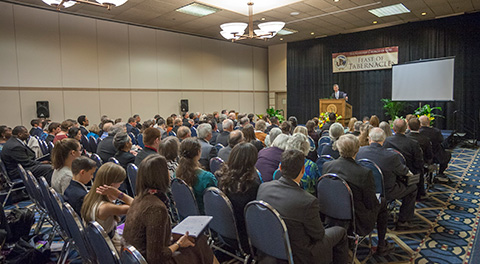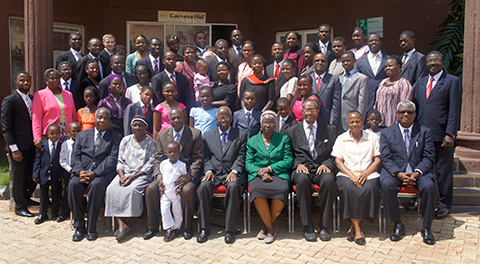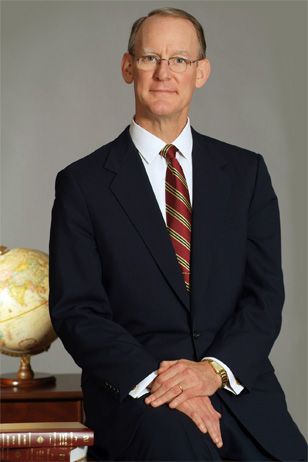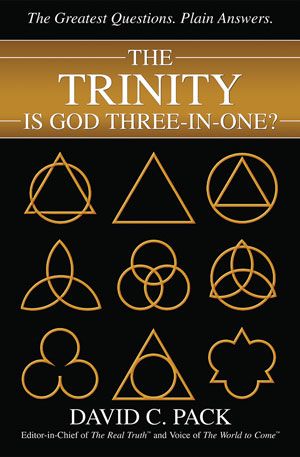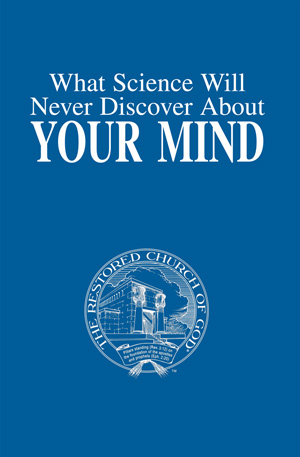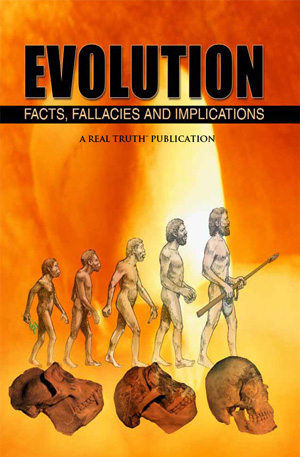People have debated the existence of God for thousands of years. Most conclude that it cannot be proven—one way or the other. It is surmised that the correct answer lies in the area of abstract philosophy and the metaphysical. Others become agnostics, asserting that they “don’t know” if God exists. Those who do accept God’s existence often do so passively, merely because they were taught it from childhood. Some do not even care. Such people probably cannot be moved from their apathy. Atheists have concluded that God does not exist. These people represent a special category that God describes as, “The fool has said in his heart, There is no God” (Psa. 14:1). This scripture is repeated in Psalm 53:1. This booklet will explain why God calls atheists “fools.”
Over thirty-seven years ago, I learned of absolute proof that God exists. My studies lasted 2 1/2 years. I came to realize that I did not have to accept His existence “on faith.” Since that time, science has learned much more and the “case” for God’s existence has become far stronger than at any time in history. This booklet presents numerous absolute, immutable proofs that God does exist. After reading it, you will never again doubt the answer to this greatest of questions! Some proofs will amaze you. Others will inspire you. Still others will surprise or even excite you. All of them will fascinate you with their simplicity. We will first examine some traditional proofs and then consider material that rests on the cutting edge of scientific understanding, before returning to established proofs. You will learn from biology, astronomy, chemistry and mathematics.
Creation or Evolution?
There is an all-important question that is inseparable from the question of God’s existence. The question of whether life on Earth exists, because of blind, dumb luck and chance, through evolution, or because of special creation by a Supreme Being, cannot be avoided in studying the existence of God.
Did all life on Earth evolve over millions of years, as evolutionists assert—or did an all-powerful God author it at creation? Most people assume evolution is true, just as those who believe in God assume His existence. I also studied this question—evolution vs. creation—in depth, during the same period that I sought to prove God’s existence.
I learned that it takes far more “faith” to believe in the intellectually chic and fashionable evolutionary myth, than it does to believe in the existence of God. In fact, I learned that evolution is based entirely on faith, because no facts or proof have ever been found to support it! (We have prepared a thorough and most inspiring, 21-page, magazine-sized brochure, Evolution – Facts, Fallacies and Implications, that complements this booklet. Those who read this powerful publication will never again doubt the scientific case for Creation!)
Faith and Proof
Faith does play a role in the life of a Christian. For the person who truly wants to seek God and learn to please Him, notice:
“But without faith it is impossible to please Him: for he that comes to God must believe that He is, and that He is a rewarder of them that diligently seek Him” (Heb. 11:6). Faith is vital to a Christian. In fact, without it, no one can please God. Notice, this verse says that those seeking God “must believe that He is.” A deep belief in God, who “rewards” all who “diligently seek Him,” requires proof of His existence. After proof has been established, then—and only then—can one have faith—absolute confidence—that what he does is being recorded in God’s mind, to be remembered when he receives his reward. If you are uncertain that God exists, because proof of that existence has not been firmly established, then, under fire, your faith will wane or disappear.
But Which God?
The apostle Paul wrote, “For though there be that are called gods, whether in heaven or in earth, (as there be gods many, and lords many,) but to us there is but one God, the Father, of whom are all things…howbeit there is not in every man that knowledge” (I Cor. 8:5-7).
The religions of this world have created many gods of wood, stone and other material. Others exist only in the minds of men. The ancient Greeks alone served 30,000 gods and modern Hindus worship 5 million gods! Truly, there are, and have always been, “gods many, and lords many.” Yet, the God of the Bible created all the materials that men use to design their own gods. But, as Paul said, “there is not in every man that knowledge.”
Such unnecessary ignorance and confusion!
The God of the Bible has shown the way to peace, happiness and abundant life for all people willing to study His Instruction Book. Doing this would rid mankind of the confusion and evils that encompass this world. But, it is not our purpose here to prove that the God of the Bible is the one true God of creation. (To learn more about the nature of God, read our book The Trinity – Is God Three-In-One?)
What Science Tells Us
Be willing to examine science. As we reason, do not suppose or hope. Stand on indisputable facts. We will see facts from a broad array of different kinds of science. They will demonstrate that an all-powerful Supreme Being, of infinite intelligence, carefully provided more than sufficient proof to remove all doubt that He exists.
The Bible is God’s instruction to mankind. He expects all who are willing to read the Bible, to “Prove all things; hold fast that which is good” (I Thes. 5:21). Surely this God would not then expect us to assume His existence, while instructing us to prove everything else from His Word! (To learn more about this topic, read our booklet Bible Authority...Can It Be Proven?)
Before beginning this study, remember, assumptions do not count! Neither do superstitious myths or traditions based on ignorance! What can be known from science? Only accept facts. Think rationally and clearly. Then accept what can be proven!
The Most Perfect Clock
You probably have a watch. Without it, you would be lost in a world that demands that people “be on time.”
Some watches are more accurate than others. How accurate is yours? How long before it loses a second? When this happens, you adjust it by reckoning from a more accurate source. That source, whatever it is, is also imperfect and has to be regularly updated, though not as often, to be in accord with the Master Clock of the United States at the Naval Observatory in Washington, D.C.
For many years, until 1967, Naval Observatory astronomers “observed” the motion of the earth, in relation to the heavens, to accurately measure time. All clocks in this country were set in relation to these very precise measurements. It was God who made this Master Clock of the Universe! He set the heavens in motion and mankind learned how to use its wonderful accuracy. As marvelous as this Great Clock is, the story does not end here.
In 1967, scientists built an “Atomic Clock.” It uses Cesium 133 atoms because they oscillate (vibrate) at the rate of 9,192,631,770 times per second. This produces accuracy within one second every 30 million years! Wouldn’t you love a watch that accurate? Cesium 133 atoms never vary a single vibration. They are steady—constant—reliable—and cannot be an accident of nature that just “happens” to always turn out exactly the same. God had to design the complexity and reliability of these atoms. No honest mind can believe otherwise. Men merely learned how to capture what God designed, for use in time measurement. Again, the story continues.
Doubters, consider this! Scientists in Boulder, Colorado, at the National Institute of Standards and Technology, have built an optical clock that is even more accurate. How? By measuring time with light. Time is now measured in what are called femtoseconds—or a million-billionth of a second. These clocks use mercury ions at their “heart” to count the number of times they vibrate in a second.
Optical frequencies regularly oscillate at one million-billion (1,000,000,000,000,000—one quadrillion) times per second. By using lasers and “cooled down” mercury ions, scientists have harnessed God’s precision to better measure time. Optical clocks only slip by one second every 30 BILLION years! This is 1,000 times more accurate than atomic clocks!
All human watchmakers use extraordinary precision in their work. Quartz watches measure time by counting the exact number of oscillations of a quartz crystal through use of a digital counter. Digital clocks use the oscillations of quartz crystals or power lines (60 cycles per second in the United States), but may also count through use of digital counters. Grandfather clocks use the swing of a pendulum, once every second and recorded by metal gears inside the clock, to keep time.
As with the movement of the heavens, men have learned to capture the reliability of Cesium 133 atoms and the movement of cooled mercury ions to count time. Their number of oscillations per second never varies. Could this perfect order be the product of an accident?
In summary, only with great time and effort, the finest watchmakers in the world can, at best, devise several kinds of relatively imprecise clocks. Can any honest, fair-minded person then believe that the three highly precise clocks—the heavens, atomic and optical clocks—came about by accident? In other words, are we to believe that while very sophisticated, humanly devised watches required the effort and ingenuity of skilled, intelligent men to create them, clocks of far greater sophistication, precision and design developed on their own? How utterly ridiculous!
You have seen absolute proof that only the “Greatest Watchmaker” could have devised these “greatest watches.”
The First Law of Thermodynamics
What is the truth of modern science regarding the origin of all matter in the universe? Do scientists tell us that it has always existed? Or have they determined that there was a moment in time in which all matter came into existence? The answer to the second question is, yes! But what is the proof that this is true?
The First Law of Thermodynamics is stated as follows: Matter and energy can be neither created nor destroyed. There are no natural processes that can alter either matter or energy in this way. This means that there is no new matter or energy coming into existence and there is no new matter or energy passing out of existence. All who state that the universe came into existence from nothing violate the first law of thermodynamics, which was established by the very scientific community who now seem willing to ignore it. In summary, this law plainly demonstrates that the universe, and all matter and energy within it, must have had a divine origin—a specific moment in which it was created by someone who was all-powerful.
With the coming of the Atomic Age, beginning with the discovery of radium in 1898 by Madame Curie, came the knowledge that all radioactive elements continually give off radiation. Consider! Uranium has an atomic weight of 238.0. As it decomposes, it releases a helium atom three times. Each helium atom has a weight of 4. With the new weight of 226.0, uranium becomes radium. Radium continues to give off additional atoms until eventually the end product becomes the heavy inert element called lead. This takes a tremendous amount of time. While the process of uranium turning into radium is very long, the radium turns into lead in 1,590 years.
What are we saying? There was a point in time when the uranium could not have existed, because it always breaks down in a highly systematic, controlled way. It is not stable like lead or other elements. It breaks down. This means there was a specific moment in time when all radioactive elements came into existence. Remember, all of them—uranium, radium, thorium, radon, polonium, francium, protactinium and others—have not existed forever. This represents absolute proof that matter came into existence or, in other words, matter has not always existed!
This flies directly in the face of evolutionary thought—that everything gradually evolved into something else. Here is the problem. You cannot have something slowly come into existence from nothing! Matter could not have come into existence by itself. No rational person could believe that the entire universe—including all of the radioactive elements that prove there was a specific time of beginning—gradually came into existence BY ITSELF!
Through your own efforts, try to build something—anything—from nothing. Even with your creative power engaged in the effort, you would never be able to do it. You will not be able—in a hundred lifetimes of trying—to produce a single thing from nothing! Then, can any doubter believe that everything in the entirety of the universe, in all of its exquisite detail, came into existence completely by itself? Be honest. Accept facts. This is proof that the existing natural realm demands the existence of a Great Creator!
The Second Law of Thermodynamics
The Second Law of Thermodynamics is best summarized by saying that everything moves toward disorder—or a condition known as entropy. This bears some explanation and we will consider several examples.
Remember that evolutionists teach that everything is constantly evolving into a higher and more complex order. In other words, they believe things continue to get better and better instead of worse and worse.
If water being heated on a stove is at 150 degrees Fahrenheit, and the burner is turned off, the temperature will drop instead of rise. It will move toward colder rather than hotter. If a ball is placed on a hill, it will always roll downhill and not uphill. Energy used to perform any particular task changes from usable energy to unusable in the performing of that task. It will always go from a higher energy level to a lower energy level—where less and less energy is available for use.
When applied to the universe, the second law of thermodynamics indicates that the universe is winding down—moving toward disorder or entropy—not winding up or moving toward more perfect order and structure. In short, the entire universe is winding down!
Even evolutionists admit that the theory of evolution and the second law of thermodynamics are completely incompatible with each other. Consider: “Regarding the second law of thermodynamics (universally accepted scientific law which states that all things left to themselves will tend to run down) or the law of entropy, it is observed, ‘It would hardly be possible to conceive of two more completely opposite principles than this principle of entropy increase and the principle of evolution. Each is precisely the converse of the other. As (Aldous) Huxley defined it, evolution involves a continual increase of order, of organization, of size, of complexity. It seems axiomatic that both cannot possibly be true. But there is no question whatever that the second law of thermodynamics is true’” (Morris, Henry M., The Twilight of Evolution, Grand Rapids: Baker Book House, 1967, p. 35).
Like a top or a yo-yo, the universe must have been “wound up.” Since the universe is constantly winding down, the second law of thermodynamics looms before us in the form of a great question: Who wound it up? The only plausible answer is God!
The Great Proof of Creation
We have established that creation demands a Creator. The next few paragraphs introduce some amazing scientific proofs of creation.
The theory of evolution is shot full of inconsistencies. Evolutionists have seized on many theories, within the overall theory of evolution, in an attempt to explain the origins of plants, animals, the heavens and the earth.
Over and over, these “theorists” try to explain how life evolved from inanimate material into more complex life forms until it reached the pinnacle—human beings.
Yet, as one geologist wrote, “It must be significant that nearly all the evolutionary stories I learned as student…have been debunked” (Dr. Derek V. Ager, Dept. of Geology, Imperial College, London, The Nature of the Fossil Record, Proceedings of the Geological Assoc., Vol. 87, 1976, pp. 1132-1133).
Perhaps the biggest reason that so many theories within the overall theory of evolution collapse is because they contain terrible logic requiring great leaps in faith to believe. Here is one example of a “debunked” theory: “Many evolutionists have tried to argue that humans are 99% similar chemically to apes and blood precipitation tests do indicate that the chimpanzee is people’s closest relative. Yet regarding this we must observe the following: ‘Milk chemistry indicates that the donkey is man’s closest relative.’ ‘Cholesterol level tests indicate that the garter snake is man’s closest relative.’ ‘Tear enzyme chemistry indicates that the chicken is man’s closest relative.’ ‘On the basis of another type of blood chemistry test, the butter bean is man’s closest relative’” (Morris, Henry M., The Twilight of Evolution, Grand Rapids: Baker Book House, 1967).
Complexity of Life
Everyone has witnessed explosions. Have you ever seen one that was orderly? Or one that created a watch or a clock? Or one that produced a single thing of exquisite design—instead of the certain result of chaos and destruction? If you threw a million hand grenades, you would see them produce chaos and destruction a million times! There would never be an exception.
Consider the following quotes, involving the likelihood of an explosion creating the entire natural realm of life all around us on Earth—let alone the beautiful magnificence and order seen no matter how far one looks out into space.
Dr. B. G. Ranganathan said, “…the probability of life originating from accident is comparable to the unabridged dictionary resulting from an explosion in a printing shop” (Origins?, p. 15). And this only speaks to the likelihood of any life at all, rather than the most highly complex forms such as large animals or human beings—let alone all the different kinds of life that exist today.
Another scientist, Sir Fred Hoyle, an English astronomer and professor of Astronomy at Cambridge University, stated, “The chance that higher forms have emerged in this way is comparable with the chance that a tornado sweeping through a junk yard might assemble a Boeing 747 from the materials therein” (Nature, Vol. 294, Nov. 12, 1981, “Hoyle on Evolution,” p. 105).
Incredible Cells and “Irreducible Complexity”
Consider the common mousetrap. Everyone is familiar with it and most have used one. Which part of a mousetrap could you remove and still have it work? The answer is—not one! As ingenious as it is, it is a very simple mechanism. But since the mousetrap cannot be made any simpler, it represents a condition called “irreducible complexity.” Certain living organisms also cannot be simplified or reduced in complexity, and survive. The removal of any single part causes the system to cease functioning. Irreducibly complex systems cannot be produced gradually, by slight successive modifications from a less complicated pre-condition. They must exist exactly as they are—whole, complete—or they cannot exist at all! Take away any part and they cease to function and, therefore, cease to live. What is the significance of this?
Charles Darwin, in his famous work, The Origin of Species, framed a great problem that he and all other evolutionists face: “If it could be demonstrated that any complex organ existed which could not possibly have been formed by numerous, successive, slight modifications, my theory would absolutely break down” (emphasis mine).
Nature contains many different biochemical systems that cannot be reduced in complexity. They are sometimes referred to as “molecular machines” and, like a four-stroke gasoline engine, cannot be simplified and still function.
Here is just one amazing quote about a single, incredible organism. It illustrates the principle we are discussing. You may need to read it two or three times to appreciate its impact. Its length is necessary to illustrate the complexity of just one molecular machine. The quote is from the article Molecular Machines by Michael J. Behe, and the emphasis is mine:
“Earlier we discussed proteins. In many biological structures proteins are simply components of larger molecular machines. Like the picture tube, wires, metal bolts and screws that comprise a television set, many proteins are part of structures that only function when virtually all of the components have been assembled. A good example of this is a cilium. Cilia are hairlike organelles on the surfaces of many animal and lower plant cells that serve to move fluid over the cell’s surface or to ‘row’ single cells through a fluid. In humans, for example, epithelial cells lining the respiratory tract each have about 200 cilia that beat in synchrony to sweep mucus towards the throat for elimination. A cilium consists of a membrane-coated bundle of fibers called an axoneme. An axoneme contains a ring of 9 double microtubules surrounding two central single microtubules. Each outer doublet consists of a ring of 13 filaments (subfiber A) fused to an assembly of 10 filaments (subfiber B). The filaments of the microtubules are composed of two proteins called alpha and beta tubulin. The 11 microtubules forming an axoneme are held together by three types of connectors: subfibers A are joined to the central microtubules by radial spokes; adjacent outer doublets are joined by linkers that consist of a highly elastic protein called nexin; and the central microtubules are joined by a connecting bridge. Finally, every subfiber A bears two arms, an inner arm and an outer arm, both containing the protein dynein.
“But how does a cilium work? Experiments have indicated that ciliary motion results from the chemically-powered ‘walking’ of the dynein arms on one microtubule up the neighboring subfiber B of a second microtubule so that the two microtubules slide past each other. However, the protein cross-links between microtubules in an intact cilium prevent neighboring microtubules from sliding past each other by more than a short distance. These cross-links…convert the dynein-induced sliding motion to a bending motion of the entire axoneme.
“Now let us sit back, review the workings of the cilium, and consider what it implies. Cilia are composed of at least a half dozen proteins: alpha-tubulin, beta-tubulin, dynein, nexin, spoke protein, and a central bridge protein. These combine to perform one task, ciliary motion, and all of these proteins must be present for the cilium to function. If the tubulins are absent, then there are no filaments to slide; if the dynein is missing, then the cilium remains rigid and motionless; if nexin or the other connecting proteins are missing, then the axoneme falls apart when the filaments slide.
“What we see in the cilium, then, is not just profound complexity, but also irreducible complexity on the molecular scale.” You see the point!
This was terribly complicated. In a way, that is the point! Organisms are all complicated—some wonderfully so. And yet they cannot be reduced, diminished or simplified in their complexity. They had to come into being exactly as they are, because they never could have arrived at their present condition gradually.
We should stand in awe of any God great enough to be able to design and create cilia!
Amino Acids, Proteins and DNA
Let’s take a journey deep into the cells of all living organisms. This will be unlike any journey you have ever taken before.
Immediately, we see a world of such exquisite detail, design, complexity, inter-dependence and specificity as to boggle the mind. Let’s paint a picture.
Amino acids must link together to form a chain, thus making a protein. Notice: “Yet, amino acids form functioning proteins only when they adopt very specific sequential arrangements…like properly sequenced letters in an English sentence. Thus, amino acids alone do not make proteins any more than letters alone make…poetry. In both cases, the sequencing of the constituent parts determines the function [or lack of function] of the whole. Explaining the origin of the specific sequencing of proteins (and DNA) lies at the heart of the current crisis in materialistic evolutionary thinking” (Stephen C. Meyer, DNA And Other Designs, p. 9—emphasis mine).
A brief discussion of proteins and sequencing is necessary. Proteins must appear in exact sequences to cause specific chemical reactions or build specific structures within the cells. This action is called specificity. It is because of specificity that proteins cannot substitute for one another. They are as different in purpose as an axe, a drill, a hammer and a screwdriver.
This extensive quote summarizes the enormous difficulty of believing that DNA happened by chance: “The complexity and intricacy of the DNA molecule—combined with the staggering amount of chemically-coded information it contains—speak unerringly to the fact that this ‘supermolecule’ simply could not have happened by blind chance. As Andrews has observed.
“It is not possible for a code, of any kind, to arise by chance or accident…A code is the work of an intelligent mind. Even the cleverest dog or chimpanzee could not work out a code of any kind. It is obvious then that chance cannot do it…This could no more have been the work of chance or accident than could the ‘Moonlight Sonata’ be played by mice running up and down the keyboard of my piano! Codes do not arise from chaos.” (Andrews, E.H., 1978, From Nothing to Nature, pp. 28-29).
Here is a second statement: “Indeed, codes do not arise from chaos. As Dawkins correctly remarked: ‘The more statistically improbable a thing is, the less we can believe that it just happened by blind chance. Superficially, the obvious alternative to chance is an intelligent Designer’ (1982, p. 130, emp. Added). That is the exact point the theist is making: an intelligent Designer is demanded by the evidence” (Bert Thompson, Ph.D., The Case For The Existence of God [Part II]).
Dr. Carl Sagan wrote an article for the Encyclopaedia Britannica about DNA. He said, “The information content of a simple cell has been estimated at around (one trillion) bits.” He then went on to explain the enormity of this number by stating, “…that if one were to count every letter of every word of every book in the world’s largest library (over ten million volumes), the final tally would be approximately a trillion letters. Thus, a single cell contains the equivalent information content…of more than ten million volumes” (“Life on Earth,” Vol. 10).
In conclusion, regarding DNA, nothing works unless everything works at the same time. It could not have gradually come into existence. Special creation is required for DNA to exist!
“Tiny Engines” Inside Cells
We need to look at one more example of molecular machines to better appreciate the complexity of cells.
Japanese and German scientists have now discovered the smallest of nature’s machines, called “tiny engines.” Consider this advanced research on these remarkable little engines.
As you read this quote, ask yourself where they came from: “A group of Japanese scientists exploring the crystal structure of the F1-ATPase enzyme discovered nature’s own rotary engine—no bigger than ten billionths by ten billionths by eight billionths of a meter. The tiny motor includes the equivalent of an engine block, a drive shaft, and three pistons. It runs at speeds between 0.5 and 4.0 revolutions per second. This motor not only ranks as the smallest ever seen, it also represents the smallest motor that the laws of physics and chemistry will allow.
“In Germany, a research team used the new instruments to examine an enormous molecule, the yeast 26S proteasome. Though not the largest molecule in existence, the yeast 26S proteasome contains over two million protons and neutrons and is the largest non-symmetrical molecule mapped to date. This molecule can only be described as a ‘wonder.’ It serves as an intracellular waste-disposal and recycling system” (Hugh Ross, Ph.D., Small-scale Evidence of Grand Scale Design).
These organisms could never have evolved gradually. No wonder God says of those who do not believe in His existence, “The fool has said…There is no God.”
Life Requires a LIFEGIVER
What about the presence of all life on Earth today? Where did it come from? How did it get here? The Bible states that God created all life during the first six days of the creation week of Genesis 1. Is this true, or did life come into existence by itself?
As with Uranium 238, and its provable moment of beginning, the great pattern of all life is that it can only come from other pre-existing life. This is called the Law of Biogenesis. All first-year biology students know it.
When examining tiny organisms, such as protozoa and bacteria, it can be demonstrated that life only comes from life. There are many kinds of life, but each continues to reproduce the same kind over and over. This is indisputable.
Life can never come from inanimate (non-living) objects. Evolutionists theorize that inanimate objects, under certain unknown circumstances in the misty past, somehow spontaneously gave birth to very primitive life forms. This presents enormous problems for anyone familiar with the nature and complexity of simple cells.
Biologists understand that all cells can only come from pre-existing cells. Here is why. Cells, even in their simplest and most rudimentary form, are extremely complex. Consider: “The simplest organism capable of independent life, the prokaryote bacterial cell, is a masterpiece of miniaturized complexity which makes a spaceship seem rather low-tech” (Darwin on Trial, Philip Johnson, p. 102). The next source is equally powerful in explaining both the complexity of the cell and its origin: “The cell needs all its basic parts with their various functions, for survival; therefore, if the cell had evolved, it would have meant that billions of parts would have had to come into existence at the same time, in the same place, and then simultaneously come together in a precise order” (Origins?, Ranganathan, B.G., p. 15).
Will skeptics ignore the truth that it is impossible to have life without a lifegiver? Only God has Life inherent in Himself. This is, after all, what makes Him God. No one created God, because He has Life inherent in Himself. But is this God merely some kind of blind power, some kind of dumb “first force?” Let’s reason together.
The Extraordinary Human Mind
Stop and think! Consider all of the works of nature around you—both on Earth and in the heavens.
First, consider the many different kinds of planets, stars and galaxies. Each is its own marvel. Second, consider all the species of plants on Earth today. There are millions, diverse in color, shape, size, beauty, length of life, etc. I have spent much of my life studying and planting many kinds of plants. The brilliance of their various designs and purposes never ceases to amaze me! I am more fascinated with these living plants, than with stars and other objects throughout the heavens.
A side note should be considered at this point. All of the food that exists on Earth today is perfectly designed for either human or animal consumption. It is constructed so that it contains just the right amounts of different elements necessary to sustain various life forms. Every time man tries to alter or improve food, he seems to pollute, ruin, devitalize, inject with poison, genetically re-engineer, or in some manner reduce its perfection into something inferior to what he started with. If mankind could just leave food alone, and eat it as God created it, sickness, disease and every form of nutrition-related human infirmity would disappear.
The germination, growth, development and maturation of plants into the many kinds of food, available just to human beings, represents its own series of miracles far too complex to recount here. It could command its own book just to explore it beyond even the most superficial overview.
But think! Who is more intelligent? God—who made perfect food, or men—who find every possible way to alter and degrade it before consuming it? Take the time to ponder this question.
Third, consider the nearly one million different kinds of creatures (plus the estimated several million additional kinds of insects). Because these creatures are animate, they are even more marvelous and fascinating than is the world of plants. Their diversity in color, shape, size, beauty, length of life, etc., is comparable to plants.
What is the point? As fascinating, marvelous, beautiful and amazing as are all the things described here, surely nothing is as amazing as the human mind. It is the absolute pinnacle of all living organisms. None can doubt this.
The Limits of Your Creative Power
Now think about what mankind has been able to produce. He can build houses, telephones, trains, automobiles, planes, rockets, computers, fax machines and other sophisticated devices that are practically limitless in complexity and usefulness.
However, all this creative genius has a simple limit. No man, or group of men, you and I included, can create anything as marvelous as the human mind. Everything that man creates is inferior to his own mind. Try to think of a single thing that has ever been created by men that is superior to the minds who created it. You will not think of anything.
Here is the question: Who or what created your mind—and you? King David said, “…for I am fearfully and wonderfully made” (Psa. 139:14). Surely this is most true of the human brain. Be honest with yourself. Can you possibly believe that some kind of blind, dumb power or force—of less intelligence than yourself, or of no intelligence—created your mind? Remember, you can create nothing superior to your mind. So, only a greater mind could create your mind.
Do not insult yourself by suggesting that your extraordinary creative powers of intelligence, reason, logic, thought, volition and ingenuity are a product of mere dumb luck! (To learn more about this topic, read our booklet What Science Will Never Discover About Your Mind.)
One Great Step Further
Consider what we have discussed about the universe and its contents—including stars, planets, galaxies, plants, animals, humans and the human mind!
Assume for a moment that you have all power to create whatever you wish. Do you think that you could have created this much beauty, majesty, design, size, precision of engineering and magnificence on your own, with no help from one single additional person? Remember, you would have no pattern to copy. You would be “on your own.”
Would you be able to design approximately one trillion galaxies, each containing an average of 100 billion stars—with no pattern to copy as you did this? Would you think to create light and cause it to travel at 186,000 miles per second? Could you think to make sound move at 660 miles per hour? Could you create every kind of atom known to science and include every sub-atomic particle within them? Would you then think you possess the ability to merge various atoms into complex molecules able to serve a myriad of indescribably complicated purposes?
Would you think yourself able to design millions of plants—many of which are utterly interdependent upon one another? Would you then be up to the task of designing, without a single pattern to follow, several million animals and insects, which are not only perfectly interdependent with one another but also interdependent with, and dependent upon, the entire plant world? Could you then put all of the food, for both plants and animals, in place, so that they would be perfectly sustained throughout whatever time you had allotted for their existence? I could go on and on, but you see the point.
Now be careful! Just as you do not want to insult yourself by believing that your mind is a product of dumb luck, be sure that you do not insult God by suggesting that all of the universe and its contents could just happen into existence—entirely by itself! If there are ignorant, foolish atheists willing to believe that this could all occur on its own, then honest, intelligent people would never believe such folly, simply because ignorant men assert it!
Through reason and sheer plainness of logic, we now have absolute proof that only a Great Being of Superior Intelligence could stand as the Designer and Architect of the entire universe and all complex life within it—including the pinnacle of His creation, your human mind!
The Fossil Record Gap
Evolutionists once referred more often to evidence from the “fossil record.” Does such evidence exist? Do bones and artifacts from millions of years ago tell a story—offer convincing proof—that man evolved from simple organisms? What is the truth of the scientific record? Remember, we want facts—proof—not theories requiring faith to believe them!
This quote, from Dr. Colin Patterson, Senior Paleontologist at the British Museum of Natural History in London, in a letter to L. Sunderland, summarized the “fossil problem”: “…I fully agree with your comments on the lack of direct illustrations of evolutionary transitions in my book. If I knew of any, fossil or living, I would certainly have included them…Yet Gould and the American Museum people are hard to contradict when they say there are no transitional fossils…I will lay it on the line—there is not one such fossil for which one could make a water tight argument.”
Some Fossils
In the 1920s, a single tooth was found in Western Nebraska at the Snake Creek quarry. Scientists came forward offering this tooth as proof that evolution had occurred and purported it to be a “missing link.” Because of where it was discovered, the human-like sketch drawn around it was called “Nebraska Man.”
Much “to do” was made of this discovery. It was big news. Evolutionists rejoiced. But a funny thing happened on the way to the theory of evolution. Five years later, someone decided to ask a farmer his opinion of the tooth. His answer was to identify it as a “pig’s tooth!” More excavation at the site of the “find” proved that the rest of the skeleton did, indeed, represent some kind of peccary (pig).
It is often bones, or even bone fragments (and some of these have been determined to be hoaxes) that cause evolutionists to assert that important “links” from the fossil record have been discovered. Merely because someone found a piece of bone, sophisticated artist renderings are then presented, assigned names and offered as convincing visual proof that evolution occurred.
“Orce Man” was based on what turned out to be the skullcap of a donkey. “Ramapithecus Man” was simply a baboon skull. “Piltdown Man” was a hoax and “Neanderthal Man” was determined to be severely bow-legged simply because he had rickets. He was assuredly not proof from the fossil record of a half-ape, half-man transitional creature.
There is a desperation in the thinking and actions of many evolutionary scientists. The following quotes demonstrate their approach:
“A five million year old piece of bone that was thought to be the collarbone of a human like creature is actually part of a dolphin rib…The problem with a lot of anthropologists is that they want so much to find a hominid [human] that any scrap of bone becomes a hominid bone” (Dr. Tim White, anthropologist, Univ. of California, Berkeley, New Scientist, April 28, 1983, p. 199). “In fact, evolution became in a sense a scientific religion; almost all scientists have accepted it and many are prepared to ‘bend’ their observations to fit in with it” (H.S. Lipson, FRS, Prof. Of Physics, Univ. of Manchester, UK, ‘A Physicist Looks at Evolution,’ Physics Bulletin, Vol. 31, 1980, p. 138).
Here are the facts. Absolutely no transitional forms exist anywhere in the fossil record. While evolutionists will suggest that it took “50 million years for a fish to evolve into an amphibian,” the simple truth is that there are no transitional fossil forms to prove this. There are no creatures found that evidence partial fins, partial feet or partially evolved brains, legs, eyes, organs or other body parts.
The following comes from the “father” of evolutionary thinking: “Why, if species have descended from other species by insensibly fine gradations, do we not everywhere see innumerable transitional forms? Why is not all nature in confusion instead of the species being, as we see them, well defined?” (The Origin of Species, Charles Darwin, ch. 6.)
Consider a statement regarding how bone fragments are supposed to represent entire human skeletons within various stages of the fossil record. Dr. Richard Leakey, who was at one point considered the most famous fossil anthropologist in the world, said that the skull of the famous discovery, “Lucy” (known as Australopithecus afarensis), is so incomplete that most of it is “imagination made of plaster of paris.” He said that no firm conclusions could be made about what species she was, even though she was assigned the age of 3.5 to 4 million years old. I have personally seen a photograph of her “skeleton,” and it is meaningless.
The front cover of a well-known national news magazine showed a picture of an ape’s head accompanying an article entitled “How Apes Became Human.” The article was a pitiful attempt to first connect a toe bone to other bones found ten miles away from it, and then to depict them as proof of evolution. It speaks of evolution as a foregone conclusion.
The article was filled with uncertain phrases like “close to answering,” “what appears to be,” “people have speculated,” “we are suggesting,” “still something of a mystery,” “probably,” “about,” “presumably,” “maybe,” etc. These phrases are endless. Yet the artwork and diagrams make the flimsy, speculative “evidence” look like absolute proof.
The reader is even left with the impression that the writers were themselves uncertain and uncomfortable. Mixed with baseless assumptions, the artwork lends credibility through sensationalism, giving it “sale ability.”
Consider! There are no links from plants to animals, reptiles to birds and mammals, etc. The fossil record shows that animals appear suddenly. When this was recognized, the whole theory of “micro-evolution” collapsed, and evolutionists admitted as much. They then decided that possibly the fossil record could best be described as indicating “macro-evolution,” sometimes referred to as “punctuated equilibrium” or “the hopeful monster theory.” This ludicrous idea suggests a reptile could suddenly lay an egg, which would hatch a bird.
So many people seem willing to fall for ridiculous ideas because they have been told throughout their lives that evolution is a fact and assume that it cannot be wrong if “everyone believes it.” One source admitted, “That living things are suited for their environment better explains the fact that they were created for it not that they evolved into it” (Origins?, Ranganathan, B.G.).
After all is said and done, the fossil record has never revealed what evolutionists have hoped for. The record gives distinct evidence of one fact—sudden, special creation of all life in a fully-formed condition! To believe anything else is to be dishonest with the evidence.
The Amazing Human Eye
The balance of this booklet contains a series of brief examinations of various examples reflecting God’s creative genius and bear testimony to a literal, divine creation. Each of these miracles of engineering defies atheists and evolutionists! Think carefully about what you are reading and ask yourself if even one of them could have evolved.
Begin with the human eye. This mechanism is spectacularly complex and is a particularly inspiring testimony to the greatness of God’s supreme intelligence.
Here are three statements from Dr. David N. Menton. The first represents the magnitude of difficulty in having the human eye evolve to its current state of extraordinary design and complexity:
“The most amazing component of the camera eye is its ‘film’ or retina. This light sensitive layer, which lines the back of the eye ball, is thinner than a sheet of Saran Wrap and is vastly more sensitive to a wider range of light than any man-made film. The best man-made film can handle a range of 1,000-to-one. By comparison, the human retina can handle a dynamic range of light of 10 billion-to-one (or 10 million times more) and can sense as little as a single photon of light in the dark! In bright daylight, the retina bleaches out and turns its ‘volume control’ way down so as not to overload.
“The light sensitive cells of the retina are like an extremely complex high gain amplifier. There are over 10 million such cells in the retina and they are packed together with a density of 200,000 (per millimeter) in the highly sensitive fovea. These photoreceptor cells have a very high rate of metabolism and must completely replace themselves about every 7 days! If you look at a very bright light such as the sun, they immediately burn out but are rapidly replaced in most cases. Because the retina is thinner than the wavelength of visible light it is totally transparent. Each of these minute photoreceptor cells is vastly more complex than the most sophisticated man-made computer.”
Now notice: “The evolutionist Dr. Ernest Mayer once said: It is a considerable strain on one’s credulity to assume that finely balanced systems such as certain sense organs (the eye of vertebrates or the bird’s feather) could be improved by random mutations.”
Even Darwin once said that the very thought of the complexity of the eye gave him chills. Here is another reason Darwin said this. This quote, while inspiring, certainly is chilling: “It has been estimated that 10 billion calculations occur every second in the retina before the light image even gets to the brain! It is sobering to compare this performance to the most powerful manmade computer. In an article published in the computer magazine, Byte (April 1985), Dr. John Stevens said: ‘To simulate 10 milliseconds of the complete processing of even a single nerve cell from the retina would require the solution of about 500 simultaneous non-linear differential equations one hundred times and would take at least several minutes of processing time on a Cray supercomputer. Keeping in mind that there are 10 million or more such cells interacting with each other in complex ways it would take a minimum of a hundred years of Cray time to simulate what takes place in your eye many times every second’” (Dr. David N. Menton, Ph.D., The Eye, Missouri Assoc. for Creation, Inc.—emphasis mine).
You are left to draw your own conclusions about how such a marvelous organism—the human eye—could have evolved. No wonder my own optometrist told me that he believes that the eye did not evolve. He understands that it could not! It was “invented” by the Great Inventor.
Australian Termites
Next, we look at a tiny, little-known creature—the Australian termite. This particular termite differs from all others. Actually, it is four creatures in one, and each depends on the others for continued existence. This termite represents a case in which you cannot have one without all the others. Consider this:
“A curiosity I studied in microbiology class was a microorganism called Mixotricha Paradoxa that lives in the gut of Australian termites. When it was first discovered, it looked as if it was covered with a bunch of curly hairs. Looking at it closer, it was revealed that these were not hairs at all, but spirochetes, which were a totally different type of microorganism. On the Mixotricha, there were bumps or appendages where the spirochetes attached, and bacillus which lodged on the other side of the bump. The spirochetes provided a means of locomotion for the entire colony of microorganisms. They are three totally different germs that decided to live together in a community. So, what you have is an interdependence between a large microorganism, a spirochete, a bacillus, an Australian termite, and even the trees the termite feed upon. I suppose if you are an evolutionist, you would have to believe that at one point in time they formed a committee and decided to all work together; the Mixotricha ‘developing’ bumps where the spirochetes could bury their heads and behind which the bacillus could hide; all of whom ‘decided’ to live in the gut of a termite” (Douglas B. Sharp, The Revolution Against Evolution, ch. 5—emphasis mine).
Obviously, this illustrates the case for special creation of all these creatures at the same time. They could not have developed separately and ever made it to the point where they could “rendezvous” and forever spend their existence interdependent and together.
Koalas and Eucalyptus Trees
Most are familiar with cuddly koala “bears” and have at least heard of Eucalyptus trees. They have a special relationship. Each is native to only one place on Earth—Australia. Koalas eat nothing but eucalyptus leaves, often living their entire lives in one grove. They also derive moisture from these leaves because they almost never drink water.
Koalas possess specific microorganisms in their digestive systems necessary to break down the elements in eucalyptus leaves that are toxic to every other creature. These toxins are actually converted into vitamins. How did koalas evolve, unless they were created with these microorganisms already present in their stomachs? Without them, they would have eaten eucalyptus leaves and died. Yet their systems are so specific that they can only survive by eating eucalyptus leaves. Many naturalists consider them to have “the most advanced digestive system on the planet.” Their low 5% protein intake, with tannins and toxins, would kill other animals.
To reject special creation by a God, evolutionists are forced to conclude, “What luck for koalas that just the right microorganisms entered their systems at the exact same time that they developed a taste for eating only eucalyptus leaves.” This proves that God created koalas.
Whales and Dolphins
The next quote demonstrates the impossibility of whales and dolphins evolving to their present state. It lies in the context of a larger statement about why there is no fossil record demonstrating various stages of transition in their development:
“We can demonstrate one such transition problem by using the example of dolphins and whales. These mammals bear their young alive and breathe air, yet spend their entire lifetime in the sea. Presumably, in order for dolphins and whales to have evolved, they must have originated from a land mammal that returned to the water and changed into a sea creature. But dolphins and whales have so many remarkable features upon which their survival depends that they couldn't have evolved! It would be a lot like trying to change a bus into a submarine one part at a time, all the while it is traveling at 60 miles per hour.
“The following is a list of transitions evolutionists have to account for in the dolphin in its evolution from some unknown land dwelling pre-dolphin: (1) The nose would have to move to the back of the head. (2) Feet, claws, or tail would be exchanged for fins and flippers. (3) It would have to develop a torpedo shaped body for efficient swimming in the water. (4) It would have to drink sea water and desalinize it. (5) It's entire bone structure and metabolism would have to be rearranged. (6) It would need to develop a sophisticated sonar system to search for food.
“Could the dolphin acquire these features gradually one at a time over a period of millions of years? What about the transitional stages? Would they have survived with just some of these features? Why is there a total absence of transitional forms fossilized?
“Consider the whale and its enormous size in comparison with the plankton it feeds upon. The whale is a nautical vacuum cleaner, with a baleen filter. While it was ‘developing’ this feature, what did it feed upon before? For me, it takes a great stretch of the imagination to picture the evolution of dolphins and whales” (Douglas B. Sharp, The Revolution Against Evolution, ch. 5.).
It must be concluded that whales and dolphins were created!
What About Hummingbirds?
The briefest overview of birds reveals some remarkable facts. Virtually every bird builds its nest in a different way. Courtship behavior, sexual roles and reproductive activity are different among nearly every species. In one bird, the roles of the male gathering the food while the female sits on the eggs are reversed. And when did the sexes diverge—for birds or any other animal? (Even some plants are male and female. How did this happen?)
Hummingbirds represent true genius. They weigh one-fourteenth of an ounce and, like helicopters, can fly forward, backward, sideways and can hover in mid-air. Their flight mechanism is incredibly complex and the quills in their feathers are stronger for their weight than any structure designed by man. These quills constantly change shape to adjust for wind and air pressure. The leading vane of their feather functions much like a propeller, to offer lift and propulsion.
Three-quarters of their entire weight is in their wing muscles. They possess a kind of jet-assisted takeoff mechanism that they can use during landings and takeoffs. Air flows only one way into their lungs so as to bring a constant supply of oxygen for such strenuous high-speed flight. They also possess retractable landing gear, a migration navigation system, streamlining and camouflage and an extraordinary respiration system where they can store extra air inside their hollow bones. In turn, this provides buoyancy and an internal air conditioner. Hummingbirds must eat continuously to satisfy their high level of metabolism. To stop eating would mean death. Only by undergoing a kind of “hibernation” at night, can they survive. Could all this have evolved or just happened?
Like the bumblebee, which also appears to completely defy the laws of physics in its ability to fly, the hummingbird is just as unique but is practically an aerodynamic perfection. Only God could have made such an efficient flying machine. No aeronautical engineer has ever designed anything close to this tiny marvel of flight!
And Fish?
The angler fish, the archer fish, and the anableps are three fish that literally swim in the face of evolution.
The female angler fish has a lure hanging from an appendage extending from the front of her nose. It lures fish close so that she can strike and swallow them. The male does not have one because he never eats. Rather, he attaches himself to the female, allowing the bloodstreams of both to merge, thus feeding him. Evolutionists cannot explain the angler fish.
The archer fish can shoot down bugs above the surface by squirting water at them. Water severely bends (refracts) light and should cause an impossible targeting problem for the fish. How do all archer fish instinctively know how to perfectly compute the severe angle of refraction of light in order to successfully hit their prey as they do?
The anableps is a fish with absolutely extraordinary eyes. They allow it to sit on the surface and see out of water and under water at the same time. Its eyes are literally divided into two entirely separate parts. How did evolution cause half an eye to gradually evolve so that it can see out of water and vice-versa with the other half?
What engineer has ever made such efficient submarines, whose design makes them perfect hunters, so well-suited for their needs and environment?
Design Requires a DESIGNER
We are not prepared to address the final conclusions in this booklet until we look at two more sources. More scientists are accepting that the great evidence of design all around us requires acknowledgment of a Great Designer. More are recognizing that acceptance of any other explanation forces them to deny reality. The first source sets up the second:
“Everyone concludes naturally and comfortably that highly ordered and designed items (machines, houses, etc.) owe existence to a designer. It is unnatural to conclude otherwise. But evolution asks us to break stride from what is natural to believe in what is unnatural, unreasonable, and…unbelievable…The basis for this departure from what is natural and reasonable to believe is not fact, observation, or experience but rather unreasonable extrapolations from abstract probabilities, mathematics, and philosophy” (Wysong, R. L., The Creation/Evolution Controversy, 1976).
Now for the second source:
“In concluding, it is important to realize that we are not inferring design from what we do not know, but from what we do know. We are not inferring design to account for a black box, but to account for an open box. A man from a primitive culture who sees an automobile might guess that it was powered by the wind or by an antelope hidden under the car, but when he opened up the hood and sees the engine he immediately realizes that it was designed. In the same way biochemistry has opened up the cell to examine what makes it run and we see that it, too, was designed.
“It was a shock to people of the nineteenth century when they discovered, from observations science had made, that many features of the biological world could be ascribed to the elegant principle of natural selection. It is a shock to us in the twentieth century to discover, from observations science has made, that the fundamental mechanisms of life cannot be ascribed to natural selection, and therefore were designed. But we must deal with our shock as best we can and go on. The theory of undirected evolution is already dead, but the work of science continues” (Behe, Michael J., Molecular Machines).
Certainly, true science is always in harmony with the facts. No one who believes in God or special creation need ever fear God or science based on facts!
The Probability of an Earth
Let’s take an imaginary trip to the moon and look back at earth. Consider all that we left behind in our journey. We could ask: What are the mathematical odds that the earth, with all its plants, animals, eco-systems and complex interdependence, could come into existence by itself? What are the actual odds that all this could happen—even once? What are the odds of a single earth occurring?
Numerous scientists have recognized the improbable position of our planet’s location, in the solar system, in relation to its moon. For instance, if the earth were 10% farther from the sun, it would freeze over, or if it were 10% closer to the sun, it would quickly bake. If it were 20% closer to the moon, twice daily 35-50 foot tidal waves would wash to and fro over most of the earth’s land surface at great speed.
Dr. Hugh Ross, Ph.D., sat down and carefully performed an extraordinarily complex mathematical computation. He took 123 separate parameters (factors) and calculated the odds that all 123 factors, which had to be present for the earth to exist as we know it, could have come together—“just happened”—on their own.
Some of his parameters need to be listed here to begin to appreciate the complexity of his calculations.
He computed an exact value for galaxy size, type, location, birthdate of the sun, proximity of solar nebula to a supernova eruption, number of moons, mass and distance from moons, tidal force, axis tilt of planet, planetary distance from star, global distribution of continents, thickness of planet crust, atmospheric transparency, pressure, viscosity, carbon dioxide level, amount of chlorine, cobalt, copper, fluorine, nickel, potassium (and many other elements in the earth’s crust), oxygen-to-nitrogen ratio, volcanic activity and scores more. Then Dr. Ross performed one final mathematical computation before arriving at a final conclusion on the chances of the entire universe producing even one earth.
The results of his calculation—of finding all 123 of his parameters on a single earth are: “less than one chance in 10 to the 139th power (ten thousand trillion trillion trillion trillion trillion trillion trillion trillion trillion trillion trillion) exists that even one such planet would occur anywhere in the universe.”
This represents a lot of zeros!
Only a few decades ago, the largest number known to mathematicians was a vigintillion—or one with 63 zeros. A quadrillion has fifteen zeros and a quintillion has eighteen. As gigantic as are these numbers, the odds of an earth appearing anywhere in the universe represents a number so immensely large as to dwarf a quadrillion.
Understand! The universe is inseparable from the laws of mathematics. In other words, the appearance of a single earth, anywhere in the universe, is an utterly impossible probability. Any mathematician “worth his salt” would admit that the earth was created exactly as we see it!
Embarrassed Scientists and Atheists
This booklet represents a fraction of all that I studied in preparation for writing it. It could easily be a thousand pages in length without exhausting the material available for inclusion. However, everything, including this booklet, has a reasonable limit.
Paul described those who refuse to accept the mountain of evidence proving God’s existence. He wrote, “Because that which may be known of God is manifest [obvious] in them; for God has showed it unto them. For the invisible things of Him from the creation of the world are clearly seen, being understood by the things that are made, even His eternal power and Godhead; so that they are without excuse: Because that, when they knew God, they glorified Him not as God, neither were thankful; but became vain in their imaginations, and their foolish heart was darkened” (Rom. 1:19-21). Modern science is left without excuse when it chooses to believe and teach evolution and ignores the existence of God. It has been said, “there is none so blind as he who refuses to see.” If people refuse to accept proof—evidence—truth—of the existence of God, there is absolutely nothing that can be said to erase their willful blindness. Remember, only the “fool has said in his heart, There is no God.”
One final quote from science best sums up why so many atheists and evolutionists live in a world of frustration and disillusionment:
“Finding a distinct beginning to the universe was something that most scientists did not anticipate and which made most of them, like Einstein, enormously uncomfortable. ‘There is a kind of religion in science,’ says Jastrow, ‘it is the religion of a person who believes there is order and harmony in the Universe, and every event can be explained in a rational way as the product of some previous event; every effect must have its cause; there is no First Cause.’ But here it was, a First Effect. The universe, most astronomers and physicists now agree, had a distinct beginning. There therefore must be a First Cause, a Prime Mover—God—that set the universe in motion. ‘For the scientist who has lived by his faith in the mountains of ignorance; he is about to conquer the highest peak; as he pulls himself over the final rock, he is greeted by a band of theologians who have been sitting there for centuries’” (The New American, “Divine Design,” D. Behreandt, Dec. 18, 2000).
To the Skeptic
Among the educated in the Western World, the popular terms for those who refuse to accept the authority of an all-powerful God, are “deists,” “rationalists” or, more popularly, “higher critics.”
The Bible teaches that “the carnal mind is enmity [hostile] against God: for it is not subject to the law of God, neither indeed can be” (Rom. 8:7). This is the natural tendency of all human beings—including you—although most would never believe or admit it. (Also see Jeremiah 17:9.) There is no proof, evidence, fact, logic or sound reasoning that could ever cause anyone, who is unwilling to set aside their natural, automatic prejudice against believing in and yielding to the authority of a loving God, to do so. Natural bias and prejudice against belief in an all-powerful God, who tells them how to live, is sufficient to keep most from honestly admitting the proofs contained in this booklet!
What will you do?
In his booklet Does God Exist?, Herbert W. Armstrong concluded with this statement under the subhead “Master Clock of the Universe”:
“But then you, Mr. Skeptic—you look up into the great vast sky at the master clock of the universe, which never misses a second—the perfect watch by which we must constantly set all our imperfect man-made watches—and you tell me, ‘That all just happened! There was no Great Watchmaker! No Master mind thought out and planned that vast universe, brought it into being, set each star and planet in its own exact place, and started the myriad heavenly bodies coursing through space, each in its prescribed orbit, in its orderly precision. No, it just fashioned itself, put itself together, wound itself up, and started itself running. There was no Intelligence—no planning—no creation—no God!’
“Do you say that to me?
“If you can, I answer that I do not respect your intelligence. And the God I acknowledge replies to you, ‘The fool hath said in his heart, There is no God!’ (Ps. 14:1; 53:1.)
“If you can look about you, and observe how intelligently planned and executed is everything in nature and in plant and animal life—everything we see except the bungling, botching, polluting of God’s beautiful handiwork by the clumsy hand of God-ignoring-and-rejecting man—and then say you doubt the existence of an all-wise, all-knowing, all-powerful Creator God, then I do not have much faith either in your rational processes or your sincerity as a seeker of the truth!”







